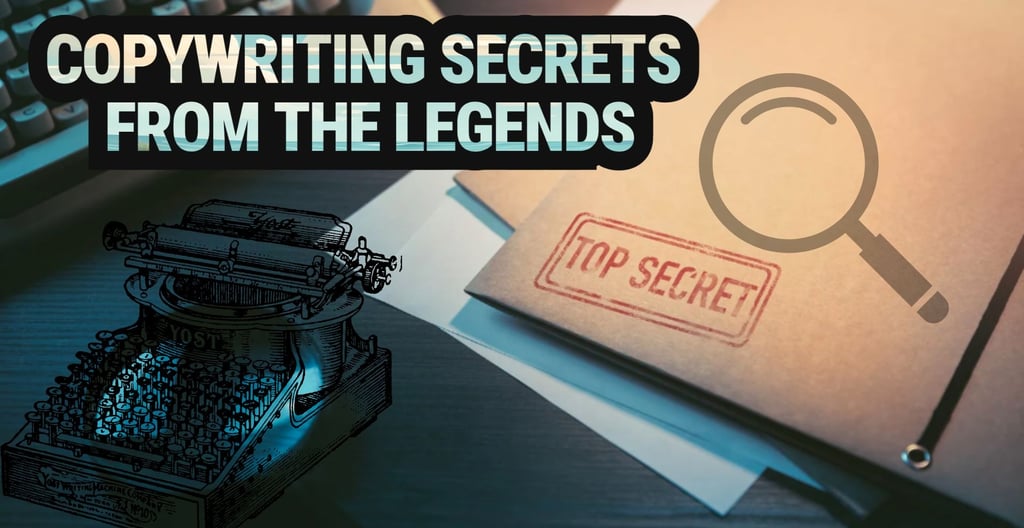Mastering the Art of Copywriting: Tips and Tricks from the Legends


In today's digital age, words are the backbone of any successful marketing strategy. Copywriting is not just about crafting catchy phrases; it's about connecting with your audience, understanding their needs, and delivering value through your message.
Whether you're a seasoned marketer or just starting out, these insights from industry legends will transform your approach to persuasive writing. Let's dive into some tips and tricks to elevate your copywriting game.
Understanding Your Audience
One of the fundamental principles of effective copywriting is understanding your audience on a deep emotional level. As Blair Warren puts it, people are driven by their dreams, fears, and suspicions. By addressing these emotional triggers, you can make your message irresistible. Gary Halbert emphasizes the importance of becoming a "student of markets" – understanding what people want to buy is the cornerstone of successful copywriting.
Tip: Conduct thorough market research to identify your audience's pain points, desires, and motivations. Use this knowledge to craft messages that resonate deeply with them.
Simplicity and Clarity
Simplicity is key in copywriting. Leo Burnett advises making your copy simple, memorable, inviting to look at, and fun to read. Howard Gossage reminds us that people read what interests them, and sometimes that's an ad. The goal is to create content that genuinely interests your audience, making your ads as engaging as any other piece of content they consume.
Tip: Use clear, concise language and avoid jargon. Make your copy visually appealing with engaging headlines, bullet points, and emojis to break up the text and maintain reader interest.
The Power of Metaphors
Metaphors are a powerful tool in copywriting, as they help explain the unknown in terms of the known. Anne Lamott highlights the effectiveness of metaphors in making complex ideas relatable. By using familiar concepts to explain new ones, you can bridge the gap between what your audience knows and what you want them to understand.
Tip: Incorporate metaphors that resonate with your audience's experiences and emotions. This can make your message more impactful and memorable.
Creativity vs. Effectiveness
While creativity is important, the ultimate goal of copywriting is to drive action. David Ogilvy emphasizes that the measure of success is not how creative your ad is, but how interesting it is to the point that it compels the reader to buy the product. Joseph Sugarman adds that you sell on emotion but justify a purchase with logic. Appealing to emotions drives initial interest, while logical reasons justify the purchase.
Tip: Balance creativity with practicality. Ensure your copy is not only creative but also persuasive enough to drive action. Use emotional appeals to grab attention and logical arguments to close the deal.
Unique Value Proposition
Many businesses compete on price because they struggle to communicate their unique value. Mish Slade points out that focusing on cheapness is a common pitfall. Instead, highlight what sets your product or service apart. Joe Sugarman advises that every product has a unique personality, and it's your job to find and emphasize it.
Tip: Identify and communicate the unique value of your offering. Focus on the benefits and transformations your product or service provides, rather than just features and price.
Emotional Turning Points
Identifying and targeting emotional turning points in your audience's lives can be a powerful strategy. Gary Halbert believes that making offers to people at these critical moments can be highly effective. These emotional turning points can be opportunities for significant conversion.
Tip: Understand the life stages and emotional milestones of your audience. Tailor your messages to address these turning points and provide solutions that meet their needs at these critical times.
The Art of Storytelling
Storytelling is a crucial element in copywriting. It helps to create a narrative that resonates with your audience and makes your message more engaging. Joanna Wiebe emphasizes that you're selling a better version of your prospects. By focusing on the transformation your product or service offers, you can create a compelling story that captivates your audience.
Tip: Use storytelling techniques to illustrate how your offering can improve your audience's lives. Highlight the journey from their current state to the transformed state they aspire to.
Conclusion
Copywriting is a powerful tool when used correctly. By connecting with your audience, focusing on value, and balancing emotion and logic, you can create compelling messages that drive results. Remember, the goal is to guide your audience toward a decision that benefits both them and your brand.
Stay informed, stay adaptable, and keep thriving!
